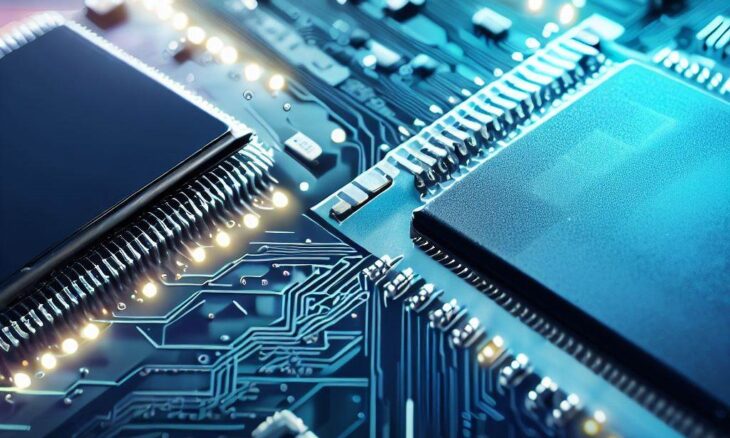Data storage solutions play an increasingly crucial role in today’s ever-evolving hardware for computers storage solutions, both private and professional environments. Performance, speed and reliability provided by storage solutions is vital. A key technology which has revolutionised how we connect and utilize storage devices today is Serial ATA or SATA; in this article we’ll give a full introduction of this essential device along with its background features applications as well as purposes in today’s computing landscape will also be examined thoroughly in depth.
1. The Evolution of Storage Connectivity
Before diving in to SATA it is vital that one understands its history of Storage Connectivity (or more specifically SATA). At the dawn of personal computers the most prevalent storage medium was hard disk drives (HDDs). They connected via various interfaces including IDE (Integrated Drive Electronics), SCSI (Small Computer System Interface), etc but these had limitations both speedwise as well as compatibility/usability-wise.
As demand for greater storage capacity and faster data transfer speeds increased, so too did the need for an effective and uniform interface, prompting SATA’s development.
2. What Is SATA?
SATA stands for Serial Advanced Technology Attachment and serves as a bus interface between computers and storage devices such as hard disk drives (HDD), solid state drives (SSD) or optical drives – such as optical drives – like HDD or SSD (Solid State Drive) storage drives or motherboards (mobos). While its predecessor Parallel ATA used parallel communication methods for data transference between drives and motherboards, while serial communication enabled faster data processing speeds than ever seen previously in storage technology.
This marked significant advancement over parallel communication used before in parallel by Parallel ATA; serial communication represented significant progress forward-move in storage technology advancement over its predecessor Parallel ATA which used parallel communications exclusively; serial transmission represented a significant leap forward-technology advancement that represented significant advancement over its predecessor in storage technology field!
Also Read: Entrepreneur: What It Means to Be One and How to Get Started
3. SATA Overview
SATA was initially developed during the latter part of the 1990s, with SATA 1.0 released for publication in 2000. SATA offered data transfers at speeds as fast as 1.5 gigabits each second (Gbps), representing an improvement over PATA which offered max speeds of only 133 megabytes each second (MBps). Due to SATA’s faster transfer rates and smaller, thinner cables, it made more suitable computing environments than PATA ever could have imagined.
SATA versions were gradually upgraded, each one providing superior performance and features.
SATA 2.0 (SATA II)
Released in 2004, SATA 2.0 or “SATA II,” was an increase over its predecessor with twice as fast transfer rates from 3.0 Gbps – making this solution especially appealing for applications which demand high performance.
SATA 3.0, more popularly known by its acronym SATA III,
first made its debut in 2009 as an upgrade from SATA 2.0 that increased data transfer speeds by six Gbps - marking an enormous leap forward for consumers and businesses alike. Since that point it has become standard practice among most consumer and enterprise storage devices alike.
SATA 3.2
was unveiled in 2013 with innovative features like SATA Express for faster data transfers via PCIe interfaces, to meet rising demands for high-speed storage solutions. This version also introduced dual channel mode options.
SATA Revision 3.3
was unveiled as the most current revision in 2016. This upgrade provided enhanced power management features as well as increased data transfer speeds on various types of devices including hybrid drives.
SATA technology boasts many key
characteristics and advantages that have contributed to its widespread acceptance in computing:
SATA III’s maximum transfer rate of 6.0 Gbps provides an impressive speed increase when compared with its predecessors and allows faster data access as well as more responsive systems.
SATA drives are extremely compatible with various devices, including HDDs, SSDs and optical drives. As it has become the standard method for connecting motherboards to storage devices it gives users access to an abundance of storage solutions.
Also Read: Understanding Pseudocode: A Comprehensive Guide
Hot-Swapping
Many SATA controllers and devices support hot-swapping. This enables a user to add or replace drives without shutting down their computer – perfect for enterprise environments that rely on uninterruptible operations.
SATA storage drives can be scaled, making them suitable for accommodating various capacities of storage ranging from SSDs and HDDs all the way up to enterprise grade storage arrays, making SATA ideal for many different uses cases.
Thin Cables
SATA cables are known for being slim and flexible, which makes the management of wires in computers much simpler compared to their bulkier PATA counterparts.
5. SATA in Modern Computing
SATA remains an essential part of modern computer environments, playing an indispensable part in numerous aspects such as:
Consumer Desktops and Laptops mes SATA is the standard interface used to connect storage devices on consumer laptops and desktops for consumer use, connecting both HDDs and SSDs that balance performance with cost – essential elements in meeting everyday computing demands.
Enterprise Storage Solutions Enterprise environments demand reliable high capacity storage with affordable pricing options that meet their storage arrays’ efficiency demands as efficiently and quickly as possible. SATA SSDs and HDDs have long been relied upon as effective yet cost-efficient options, making SATA SSDs and HDDs valuable components in server farms or data center farms with efficient yet flexible arrays that must remain efficient as time progresses.
Gaming Consoles
Many popular consoles such as those found within the PlayStation and Xbox series utilize SATA storage drives for game installation and data storage – creating faster loading times and smoother gaming experiences for gamers.
External HDDs and SSDs typically connect via SATA interface to computers for extra capacity storage as well as flexibility when looking to increase storage capacities. They allow users to expand storage capacities.
Although more modern interfaces like NVMe (Non Volatile Memory Express) have emerged as fast alternatives to SSDs, SATA remains relevant in older systems and motherboards with compatibility for SATA drives still required by older storage devices. A majority of motherboards still possess SATA ports to ensure smooth performance for older storage devices.
6. The Future of SATA
With advances in technology and advances, the role of SATA may evolve but is expected to remain an industry mainstay for some time in the future. One area to keep an eye out for is when both NVMe and SATA technologies combine on one motherboard; this gives users access to primary storage with NVMe while secondary capacity/performance storage options from SATA may combine together seamlessly on secondary capacities/performance storage needs.
Conclusion
Serial ATA or SATA is an innovative technology that has transformed how we connect and utilize storage devices in today’s computing landscape. Since SATA 1.0 to SATA III was introduced, its evolution has led to significant speed enhancements as well as greater scalability, compatibility and speed improvement throughout all connected storage. SATA plays an essential role whether you are just browsing online games for entertainment or running data centers; its implementation plays an indispensable part in meeting storage demands efficiently and reliably.
As technology develops and progresses, keeping up with its latest innovations is becoming ever more essential. SATA storage technology stands as a dependable option that is long lasting yet flexible enough to keep pace with shifting requirements in modern life.





















You must be logged in to post a comment.